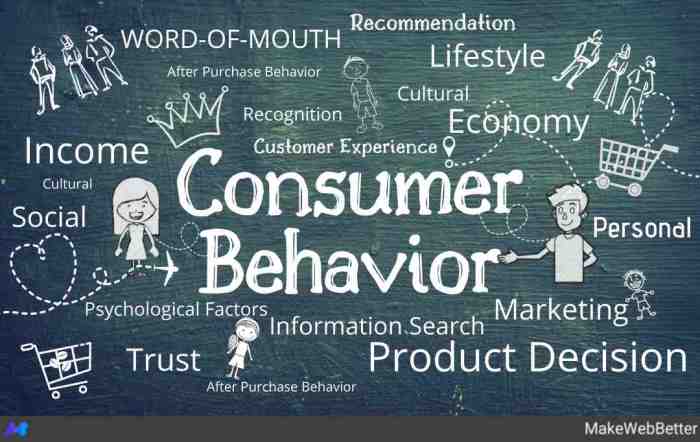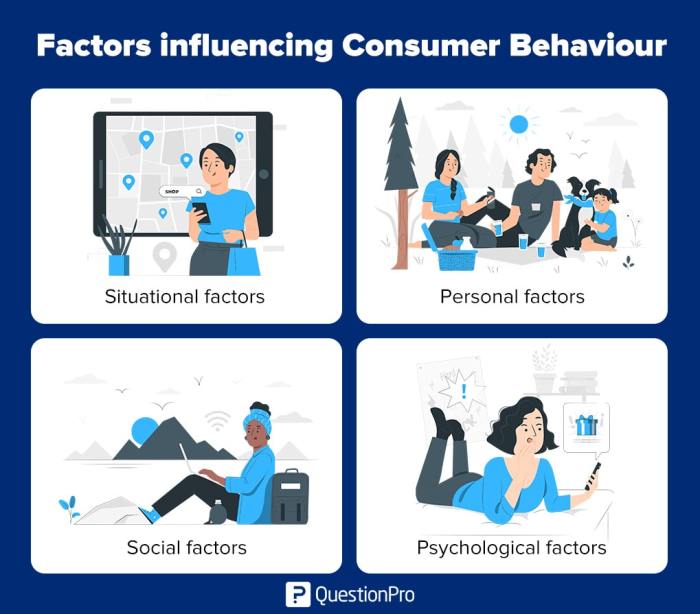Understanding Consumer Behavior takes center stage in the marketing world, where cultural influences, emotional triggers, and psychological theories shape the way consumers make decisions. Get ready to dive into a world where market research and social media play a crucial role in targeting the right audience.
Exploring the intricacies of consumer behavior reveals a fascinating landscape of motivations, perceptions, and preferences that drive purchasing patterns and brand loyalty.
Factors Influencing Consumer Behavior
Consumer behavior is influenced by a variety of factors that shape the decisions individuals make when purchasing products or services. These factors can range from personal preferences to external influences that impact how consumers interact with the market.
Cultural Differences Impacting Consumer Choices
Cultural differences play a significant role in influencing consumer behavior. The values, beliefs, norms, and customs of different cultures can shape how individuals perceive products and services. For example, a product that is considered a luxury item in one culture may be a necessity in another, leading to variations in consumer preferences and purchasing decisions.
Role of Social Media in Shaping Consumer Behavior
Social media has become a powerful tool in shaping consumer behavior. Platforms like Instagram, Facebook, and Twitter allow individuals to connect with brands, influencers, and other consumers, influencing their purchasing decisions. The rise of social media marketing has transformed how companies engage with their target audience, creating new opportunities to influence consumer preferences and buying habits.
Consumer Decision-Making Process: Understanding Consumer Behavior

When it comes to making purchasing decisions, consumers go through a series of steps that ultimately lead to their final choice. Understanding these steps is crucial for marketers looking to influence consumer behavior.
Steps Involved in the Consumer Decision-Making Process
- Recognition of Need: The process begins with the consumer recognizing a need or desire for a particular product or service.
- Information Search: Consumers then gather information about available options through various sources such as online research, reviews, or recommendations.
- Evaluation of Alternatives: Next, consumers assess different products or brands based on factors like price, quality, and features.
- Purchase Decision: After weighing the options, the consumer makes a decision to buy a specific product or service.
- Post-Purchase Evaluation: Finally, consumers evaluate their purchase to determine if it met their expectations and if they are satisfied.
Emotions and Attitudes in Consumer Decision-Making
Emotions and attitudes play a significant role in influencing consumer decision-making. Positive emotions, such as excitement or happiness, can lead to impulse purchases, while negative emotions, like fear or anxiety, may deter consumers from making a purchase. Attitudes formed through past experiences, beliefs, and cultural influences also impact how consumers perceive products and brands.
Impulsive Buying vs. Rational Decision-Making
- Impulsive Buying: Impulse purchases are made without much deliberation or consideration of alternatives. They are often driven by emotions, such as the desire for instant gratification or the need to relieve stress.
- Rational Decision-Making: Rational decisions involve a systematic evaluation of options based on logical reasoning, price comparisons, and product features. Consumers make informed choices that align with their needs and preferences.
Psychological Theories in Consumer Behavior
Understanding consumer behavior involves delving into various psychological theories that help explain why consumers make certain choices. These theories provide insight into the internal processes that influence consumer decisions.
Key Psychological Theories
- Freudian Theory: Sigmund Freud’s psychoanalytic theory suggests that unconscious desires and motivations drive consumer behavior. Marketers often tap into consumers’ deep-seated emotional needs to create connections with products.
- Maslow’s Hierarchy of Needs: Abraham Maslow’s theory posits that individuals have a hierarchy of needs, ranging from basic physiological needs to self-actualization. Understanding where consumers fall on this hierarchy can help marketers tailor their messaging accordingly.
- Cognitive Dissonance Theory: Leon Festinger’s theory explains how individuals strive for consistency in their beliefs and attitudes. Marketers can alleviate cognitive dissonance by reinforcing the positive aspects of a product post-purchase.
Motivation and Perception in Consumer Behavior, Understanding Consumer Behavior
- Consumers are motivated by both intrinsic (personal fulfillment) and extrinsic (social recognition) factors when making purchasing decisions.
- Perception plays a crucial role in consumer behavior, as individuals interpret and make sense of stimuli in their environment. Marketers can influence perception through branding and messaging.
Role of Personality in Consumer Preferences
- Personality traits such as openness, conscientiousness, extraversion, agreeableness, and neuroticism (the Big Five) can impact consumer preferences.
- Consumers with different personality traits may be drawn to specific brands or products that align with their values and self-image.
Market Research and Consumer Behavior

Market research plays a crucial role in helping businesses understand consumer behavior. By gathering and analyzing data, companies can gain valuable insights into the preferences, needs, and buying habits of their target audience. This information allows businesses to tailor their marketing strategies and product offerings to better meet the demands of consumers.
Methods of Collecting Consumer Data
- Surveys: Businesses often use surveys to gather information directly from consumers about their preferences, opinions, and shopping habits.
- Focus Groups: Companies conduct focus group sessions to gain in-depth insights by observing and interacting with a small group of consumers.
- Observational Research: This method involves observing consumers in their natural environment to understand their behavior without direct interaction.
- Big Data Analysis: Businesses analyze large sets of data to identify patterns and trends in consumer behavior, helping them make informed decisions.
Application of Market Research Insights
- Targeted Advertising: By using insights from market research, businesses can create targeted advertising campaigns that resonate with specific consumer segments.
- Product Development: Understanding consumer preferences and needs allows companies to develop products that meet the demands of their target audience.
- Pricing Strategies: Market research helps businesses determine the optimal pricing for their products based on consumer willingness to pay and perceived value.
- Customer Experience Improvement: Companies use market research insights to enhance the overall customer experience, leading to increased satisfaction and loyalty.






